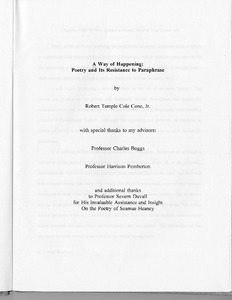| dc.rights.license | In Copyright | en_US |
| dc.creator | Cone, Robert Temple Cole, Jr. | |
| dc.date.accessioned | 2023-10-20T15:49:31Z | |
| dc.date.available | 2023-10-20T15:49:31Z | |
| dc.date.created | 1995 | |
| dc.identifier | WLURG038_Cone_thesis_1995 | |
| dc.identifier.uri | https://dspace.wlu.edu/handle/11021/36276 | |
| dc.description.abstract | When one reads a poem, it is often a challenge to understand. Particular passages may confuse the reader, and a difficult passage will prevent the reader from experiencing the poem's full effect. Most readers of English poetry have been taught to paraphrase such passages with synonymous terms to facilitate reading. If the language is familiar, the reader will better understand the poem or passage of a poem. But, as was shown, paraphrase cannot be considered an appropriate aid to reading. It essentially corrupts the poem by representing the poetic text as a unity of two dissimilar halves, form and content. In paraphrase, content maintains priority over form in the process of reading a poem. This priority mistakenly arises when one assumes that a poem bears an essential poetic meaning separable from the language in which it is expressed; that the poem's language simply bears the meaning; and that the poem's prosodic devices will be nonsense without knowledge of the meaning. Thus readers often become quite wrapped up in making sense of a poem. Habituated to analyzing (eliciting) the meaning of other verbal constructions (such as messages, written statements, orders, directions, assertions, etc.), they may mistake a poem for one of the verbal constructs on which one practices such analysis. A paraphrastic method assimilates poetry into this group of verbal creations, ignoring certain remarkable, distinctive features that exclude poetry from this kind of analysis. . . . Paraphrase necessarily assumes a form/ content division in order that there be a meaning or intent to the poem which can be extracted from the formal contents. Although a paraphrastic method cannot deny the prominence of the poem over the paraphrase, the value the method places on the paraphrase as a guide to understanding can be misleading. As has been shown, a paraphrase dissolves the poem's language to reveal its meaning, but this dissolution contradicts what were earlier presented (chapter I) as essential qualities for a poem, immutable lineation and immutable diction. How are the two reconciled? Paraphrase accepts the sacrifice, explaining that the reader can reread the poem for its prosodic qualities after understanding has been secured by means of paraphrase. But is a poem, after all, a meaning draped in the ornaments of language? No, it is not. [From concluding section] | en_US |
| dc.format.extent | 54 pages | en_US |
| dc.language.iso | en_US | en_US |
| dc.rights | This material is made available for use in research, teaching, and private study, pursuant to U.S. Copyright law. The user assumes full responsibility for any use of the materials, including but not limited to, infringement of copyright and publication rights of reproduced materials. Any materials used should be fully credited with the source. | en_US |
| dc.rights.uri | http://rightsstatements.org/vocab/InC/1.0/ | en_US |
| dc.title | A Way of Happening: Poetry and Its Resistance to Paraphrase | en_US |
| dc.type | Text | en_US |
| dcterms.isPartOf | WLURG038 - Student Papers | en_US |
| dc.rights.holder | Cone, Robert Temple Cole, Jr. | en_US |
| dc.subject.fast | English poetry | en_US |
| dc.subject.fast | English language -- Paraphrase | en_US |
